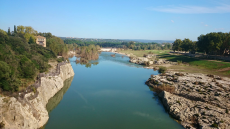
Email: nadege.preston@hotmail.com
Total Article : 82
About Me:Hi I’m Nadege and I study French at the University of Leeds, and I have just completed my third year abroad in Montpellier studying literature and enjoying the sunshine! I love art; painting and being creative, as well as photography and baking. Travelling is my favourite hobby at the moment; experiencing the French language and culture. I hope you enjoy reading some of my articles!

On the way to Avignon, we noticed signs for the Pont du Gard (located in the Vers-Pont du Gard commune), and so thought we may as well stop off to see why it seemed so popular. The car parking was very expensive – I couldn’t possibly imagine justifying spending that amount of money to see a sight – but oh how I was wrong. The Pont du Gard is an aqueduct bridge and is the most visited ancient monument in France. I am so glad I was able to visit this veritable masterpiece of construction, as since, all the teachers at University have been encouraging us to go. Built in 19 BC with the construction being credited to Marcus Vipsanius Agrippa, a Roman architect, the aqueduct bridge’s principal purpose served to bring water from Uzès to Nimes. Its uniqueness and the reason why it is listed as a World Heritage Site since 1985 is because it is the highest aqueduct bridge from the Roman Empire. To make this fact more imaginable, I will describe the way the bridge is constructed. The first level has 6 arches, which are 22 metres high, the second level has 11 arches which are 20 metres high, and the third level has 35 arches, 7 metres high. Consequently, the length (275m) and height (49m) of the Pont du Gard is highly impressive, especially as it was built with the stones found in surrounding areas.
However, the Pont du Gard, though very cleverly built as one cannot imagine how in 19 BC anything could have been constructed so well for a vast spectacular structure, the design is in fact not so well thought out. Each arch is stacked on top of one another, and therefore this requires much more effort to construct and is inefficient in its making, which can be seen when comparing the designs of newer aqueducts which have a less time-consuming and expensive design.

When visiting the Pont du Gard, you are able to walk across the bridge, and admire the river Gardon (where the aqueduct gets its name) which flows through the aqueduct bridge, through a deep valley. When walking through trails to even higher levels you can look down upon the Pont du Gard and appreciate the surrounding countryside. In summer you are able to sunbathe along the river or even go canoeing, although as I visited in October, the river beds were closed off. There are often various torrential rains and floods which occur in autumn in the south of France which meant that the river flow was dangerous. However, we enjoyed a three course meal sat opposite the Pont du Gard at the only restaurant available, which has spectacular views and really makes you admire how incredible the site is, especially as it remains two thousand years after its construction. It is therefore obvious why it is listed as a ‘Grand site de France’ – although it is the second most visited regional monument, after Mont Saint Michel – the previous UNESCO site I have written about.
IMAGE 1 - personal image. The Pont du Gard.
IMAGE 2 - personal image. The river Gardon.

0 Comment:
Be the first one to comment on this article.